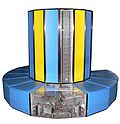Cray Urika-GD: Difference between revisions
Citation bot (talk | contribs) Removed parameters. | You can use this bot yourself. Report bugs here. | Activated by Zppix | Category:Computing stubs | via #UCB_Category |
Added a source |
||
| Line 4: | Line 4: | ||
{{Underlinked|date=July 2015}} |
{{Underlinked|date=July 2015}} |
||
}} |
}} |
||
The '''Cray Urika-GD''' graph discovery appliance, made by [[supercomputer]] maker [[Cray Inc.]], is a system that finds and analyzes relationships and patterns in the data collected by a supercomputer. Introduced in 2012,<ref>{{cite web|url=http://investors.cray.com/phoenix.zhtml?c=98390&p=irol-newsArticle&ID=1667153 |title=Cray - Investors - News Release |publisher=Investors.cray.com |date=2012-02-29 |accessdate=2015-07-24}}</ref> it was the supercomputer maker's first product offering to address the growing need of users to produce meaningful graphs based on large amounts of data, often from multiple sources, and to make useful connections among those data. |
The '''Cray Urika-GD''' graph discovery appliance, made by [[supercomputer]] maker [[Cray Inc.]], is a system that finds and analyzes relationships and patterns in the data collected by a supercomputer. Introduced in 2012,<ref>{{cite web|url=http://investors.cray.com/phoenix.zhtml?c=98390&p=irol-newsArticle&ID=1667153 |title=Cray - Investors - News Release |publisher=Investors.cray.com |date=2012-02-29 |accessdate=2015-07-24}}</ref> it was the supercomputer maker's first product offering to address the growing need of users to produce meaningful graphs based on large amounts of data, often from multiple sources, and to make useful connections among those data.<ref>{{Cite book|last=Raj|first=Pethuru|url=https://books.google.com.eg/books?id=LozDCgAAQBAJ&pg=PA237&dq=Cray+Urika-GD&hl=en&sa=X&ved=0ahUKEwjlrdqI8oPqAhWOY8AKHWtBAsYQ6AEIKTAA|title=High-Performance Big-Data Analytics: Computing Systems and Approaches|last2=Raman|first2=Anupama|last3=Nagaraj|first3=Dhivya|last4=Duggirala|first4=Siddhartha|date=2015-10-16|publisher=Springer|isbn=978-3-319-20744-5|language=en}}</ref> |
||
One example of this system in use would be a health care organization that hopes to find, among its 13 million patient records, information that doctors could use to develop treatment plans.<ref>{{cite web|url=http://www.cray.com/sites/default/files/resources/Urika-GD%20SB%20Patient%20Treatments.pdf |title=Patient Treatments |publisher=Cray.com |accessdate=2015-07-24}}</ref> Graphing the records of existing patients by categories such as illness, age, treatment and outcome may provide guidance on treating another patient. Many organizations now have vast stores of information like this—commonly called "[[big data]]"—that they can analyze and use to improve their operations, products or services. Big data is also being tapped in professional sports.<ref>{{cite web|author=Roger Craig |url=https://www.usatoday.com/story/tech/columnist/2014/07/18/big-data-and-sports-roger-craig-san-francisco-49ers-commentary/12599477/ |title=Commentary: Big data and the future of sports |publisher=Usatoday.com |date=2014-07-18 |accessdate=2015-07-24}}</ref> In 2014 Cray revealed that a [[Major League Baseball]] team (whose name has not been revealed) is using a Urika-GD appliance to graph and analyze its own performance statistics, presumably with the goal of improving its performance.<ref>{{cite web|author= |url=https://www.economist.com/blogs/babbage/2014/03/supercomputers |title=Supercomputers: Game on |publisher=The Economist |date=2014-03-10 |accessdate=2015-07-24}}</ref> |
One example of this system in use would be a health care organization that hopes to find, among its 13 million patient records, information that doctors could use to develop treatment plans.<ref>{{cite web|url=http://www.cray.com/sites/default/files/resources/Urika-GD%20SB%20Patient%20Treatments.pdf |title=Patient Treatments |publisher=Cray.com |accessdate=2015-07-24}}</ref> Graphing the records of existing patients by categories such as illness, age, treatment and outcome may provide guidance on treating another patient. Many organizations now have vast stores of information like this—commonly called "[[big data]]"—that they can analyze and use to improve their operations, products or services. Big data is also being tapped in professional sports.<ref>{{cite web|author=Roger Craig |url=https://www.usatoday.com/story/tech/columnist/2014/07/18/big-data-and-sports-roger-craig-san-francisco-49ers-commentary/12599477/ |title=Commentary: Big data and the future of sports |publisher=Usatoday.com |date=2014-07-18 |accessdate=2015-07-24}}</ref> In 2014 Cray revealed that a [[Major League Baseball]] team (whose name has not been revealed) is using a Urika-GD appliance to graph and analyze its own performance statistics, presumably with the goal of improving its performance.<ref>{{cite web|author= |url=https://www.economist.com/blogs/babbage/2014/03/supercomputers |title=Supercomputers: Game on |publisher=The Economist |date=2014-03-10 |accessdate=2015-07-24}}</ref> |
||
Revision as of 13:09, 15 June 2020
This article has multiple issues. Please help improve it or discuss these issues on the talk page. (Learn how and when to remove these template messages)
|
The Cray Urika-GD graph discovery appliance, made by supercomputer maker Cray Inc., is a system that finds and analyzes relationships and patterns in the data collected by a supercomputer. Introduced in 2012,[1] it was the supercomputer maker's first product offering to address the growing need of users to produce meaningful graphs based on large amounts of data, often from multiple sources, and to make useful connections among those data.[2]
One example of this system in use would be a health care organization that hopes to find, among its 13 million patient records, information that doctors could use to develop treatment plans.[3] Graphing the records of existing patients by categories such as illness, age, treatment and outcome may provide guidance on treating another patient. Many organizations now have vast stores of information like this—commonly called "big data"—that they can analyze and use to improve their operations, products or services. Big data is also being tapped in professional sports.[4] In 2014 Cray revealed that a Major League Baseball team (whose name has not been revealed) is using a Urika-GD appliance to graph and analyze its own performance statistics, presumably with the goal of improving its performance.[5]
References
- ^ "Cray - Investors - News Release". Investors.cray.com. 2012-02-29. Retrieved 2015-07-24.
- ^ Raj, Pethuru; Raman, Anupama; Nagaraj, Dhivya; Duggirala, Siddhartha (2015-10-16). High-Performance Big-Data Analytics: Computing Systems and Approaches. Springer. ISBN 978-3-319-20744-5.
- ^ "Patient Treatments" (PDF). Cray.com. Retrieved 2015-07-24.
- ^ Roger Craig (2014-07-18). "Commentary: Big data and the future of sports". Usatoday.com. Retrieved 2015-07-24.
- ^ "Supercomputers: Game on". The Economist. 2014-03-10. Retrieved 2015-07-24.
External links
- "Global Supercomputer Leader Cray Inc. Awarded $80 million by King Abdullah University of Science and Technology (KAUST)." Dataconomy. 18 November 2014.
- "The Evolution of Data Analytics." Infographic.
- Eileen McNulty (22 May 2014). "Understanding Big Data: The Seven V's." Dataconomy.

